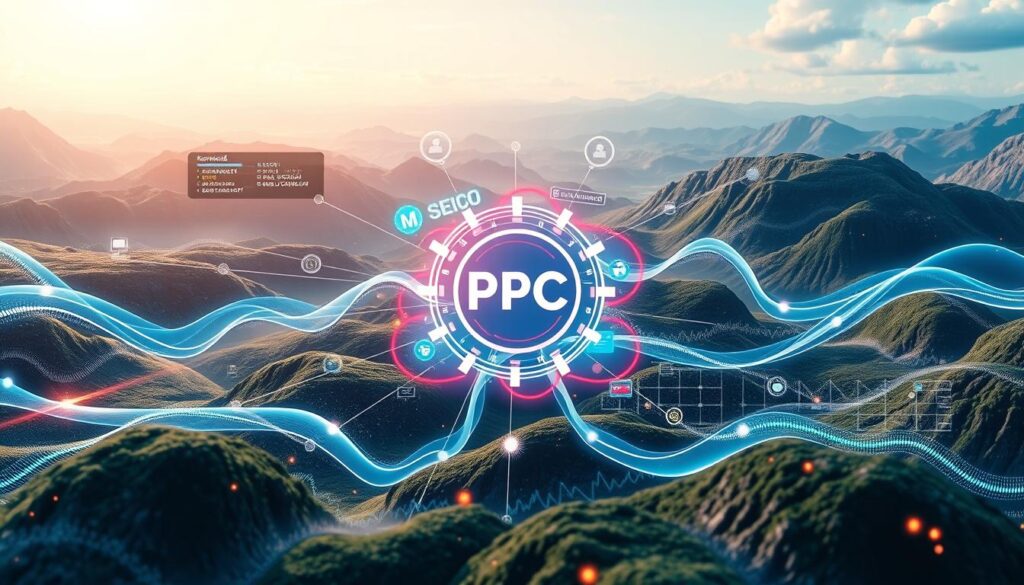SEO data alone doesn’t tell the whole story. Businesses using SEO also rely on other channels. PPC and SEO are often seen as separate, missing out on chances for better results.
This article shows how to do a seo-ppc co-optimization audit. It combines SEO and PPC data for a more complete view. SEO and PPC both aim to reach the same audience in the same space.
By working together, businesses can get better outcomes. Paid search gives SEO valuable insights. SEO, in turn, improves paid search by optimizing websites and content.
Key Takeaways
- Combining PPC and SEO data provides a more comprehensive understanding of the search landscape.
- Keyword research and search intent optimization are crucial for aligning SEO and PPC efforts.
- Ad copy optimization and landing page optimization can enhance performance and align ad quality scores.
- Conversion rate optimization and quality score improvement are essential for maximizing the efficiency of both paid and organic search.
- Audience targeting and performance tracking are key to making data-driven decisions and optimizing search strategies.
Combining PPC and SEO Data for Holistic Search Optimization
To get the most out of your search efforts, it’s key to mix data from paid and organic sources. This way, you can really understand what your audience is looking for and how well your marketing is doing. Power BI is a great tool for this, as it makes it easy to see and analyze data from different places.
Benefits of a Co-Optimization Approach
When you merge your seo-ppc co-optimization audit data, you get a fuller view of your keyword research, search intent optimization, and more. This method helps you spot where you can improve and find new chances to grow. It’s all about making your search presence stronger and more effective.
Power BI and Google Ads Paid & Organic Report
The Google Ads Paid & Organic Report is a treasure trove of information. It shows you which search terms lead to your ads, organic results, or both. By looking at this data together, you can see how your seo-ppc co-optimization audit is doing and where you can get better. Even without organic conversion data, it can point out keywords that could be more powerful for you.

Identifying Keyword Gaps and Opportunities
Finding keyword gaps and opportunities is key to a successful SEO-PPC audit. By looking at the brand’s keywords in both paid and organic searches, marketers can spot chances to shine. They can then plan strategies to lead the search engine results page (SERP).
No Paid or Organic Visibility
First, check out searches where the brand is invisible in both paid and organic results. These “dark spot” keywords are chances waiting to be seized. By focusing on keyword research, ad copy, and landing page optimization, the brand can start showing up for these searches.
Strong Organic Visibility: Top Non-Brand Keywords
Then, look at non-brand keywords where the brand already does well in organic search. This is a chance to boost search intent optimization and quality score improvement with a mix of paid and organic efforts. By using these strong keywords and targeting the right audience, the brand can lead the SERP and gain more insights.
The aim is to find and use the brand’s hidden keyword gaps and opportunities. A detailed seo-ppc co-optimization audit strategy can help. This approach can greatly improve visibility, traffic, and conversions.

SEO-PPC Co-Optimization Audit Strategies
In the digital marketing world, search engine optimization (SEO) and pay-per-click (PPC) advertising often work alone. A co-optimization audit can change this. It combines these two areas to boost online presence and attract more targeted visitors.
Low Organic Visibility with High Search Volume
One key strategy is to find keywords with high search volume but low organic visibility. These keywords, often on the second page or lower, are great for paid search. A good paid search campaign can quickly improve your brand’s visibility for these searches.
Competitor Visibility Analysis
Another important part of the co-optimization audit is looking at the competitive landscape. Analyzing your competitors’ rankings for key keywords gives valuable insights. It shows where your brand can improve and gain an edge over competitors.
By using a holistic SEO-PPC co-optimization approach, businesses can combine the best of both worlds. This approach boosts visibility and traffic and provides data-driven insights. It helps optimize ad copy, landing pages, and audience targeting for better conversion rate optimization and quality score improvement.

Evaluating True Ad Incrementality and Budget Allocation
In the world of SEO and PPC, knowing the true value of your ad campaigns is key. The seo-ppc co-optimization audit helps marketers see if spending more on certain keywords is worth it. It checks if adding more money to keywords where the brand already ranks well can bring in more clicks.
It’s interesting to find out if you should spend more on keywords where your brand is already doing well. This might seem odd, but it shows the need for ongoing testing and using data. A Google study found that spending on keywords where the brand already ranks is effective. But, the data-driven insights from the audit might show something different.
To avoid wasting money, the audit looks at cases where the brand is bidding on auctions it’s likely to win. This means they’re paying for clicks that would probably go to organic results. By spotting these situations, marketers can better use their budget allocation and avoid spending too much where they’re already seen well.
The audit’s focus on evaluating true ad incrementality and smart budget use is vital. It helps brands get the most from their marketing, improve audience targeting, and boost conversion rate optimization and quality score improvement in both organic and paid search.

By using a data-driven, performance tracking method for search intent optimization, ad copy optimization, and landing page optimization, brands can reach their full potential. This approach makes the most of keyword research and leads to better seo-ppc co-optimization results.
Conclusion
Co-optimizing seo-ppc co-optimization audit efforts is a journey of discovery and improvement. It’s key to a complete search marketing strategy. By looking at combined data, we find trends and new keyword research chances. This helps the brand stay on top in the changing search world.
Testing, measuring, and adjusting our approach is vital. It helps us make the most of our keyword portfolio.
Learning from search intent optimization, ad copy optimization, landing page optimization, conversion rate optimization, quality score improvement, and audience targeting boosts search visibility. It also drives real performance tracking results for the business. This data-driven insights way to seo-ppc co-optimization audit is crucial for staying ahead in digital marketing.
By taking a holistic, co-optimization view, brands can reach their full search marketing potential. This leads to better results and keeps them competitive. The path of ongoing improvement and optimization is vital for lasting success in the changing search world.
FAQ
What is a co-optimization audit?
How does combining PPC and SEO data benefit a search strategy?
What tools can be used for a co-optimization audit?
How can co-optimization identify keyword gaps and opportunities?
What are some co-optimization audit strategies to consider?
How can co-optimization address potential paid search cannibalization?
Source Links
- https://searchengineland.com/ppc-seo-co-optimization-audits-446907
- https://searchengineland.com/align-ppc-campaigns-business-objectives-443366
- https://www.strategybeam.com/blog/ppc-seo-working-together/
- https://www.highervisibility.com/seo/learn/integrating-seo-ppc-strategies/
- https://www.linkgraph.com/blog/holistic-search-strategy-balancing-seo-and-ppc/
- https://www.keywordinsights.ai/blog/content-gap-analysis/
- https://www.flyingvgroup.com/seoanalysis/keyword-audit/
- https://www.webfx.com/blog/seo/seo-content-audit/
- https://hawksem.com/blog/seo-and-ppc-management/
- https://www.singlegrain.com/blog/x/seo-vs-ppc/
- https://landingi.com/ppc/ppc-vs-seo/
- https://searchengineland.com/incrementality-testing-advertising-winners-losers-442852
- https://www.flow20.com/blog/budgeting-and-bidding-strategies-in-ppc-advertising-maximising-roi-with-smart-tactics/
- https://www.singlegrain.com/blog/facebook-ads-audit/
- https://www.vizion.com/blog/ppc-audit-checklist/
- https://searchengineland.com/seo-vs-ppc-pros-cons-integrated-approach-274643
- https://www.swydo.com/blog/ppc-audit/








